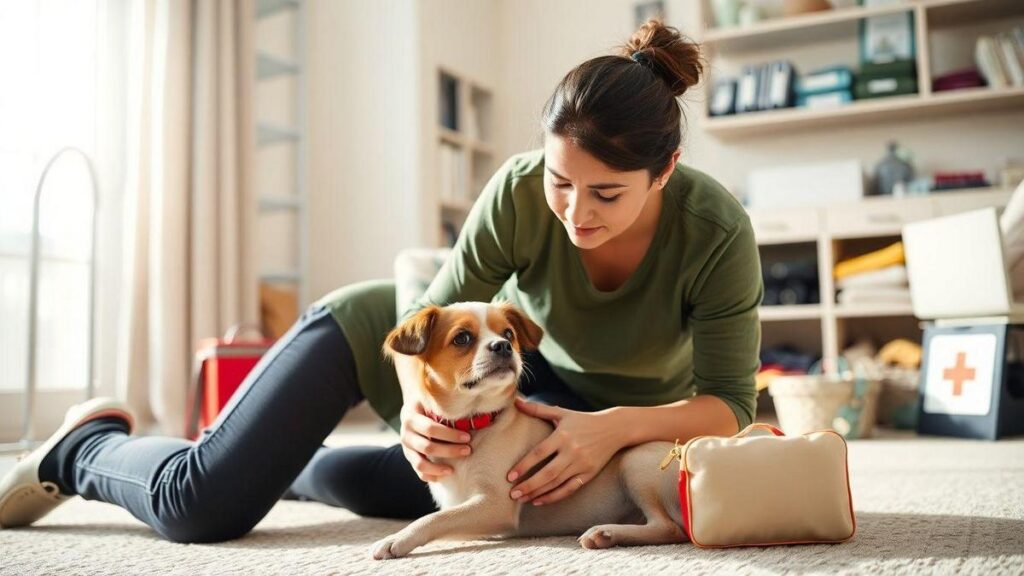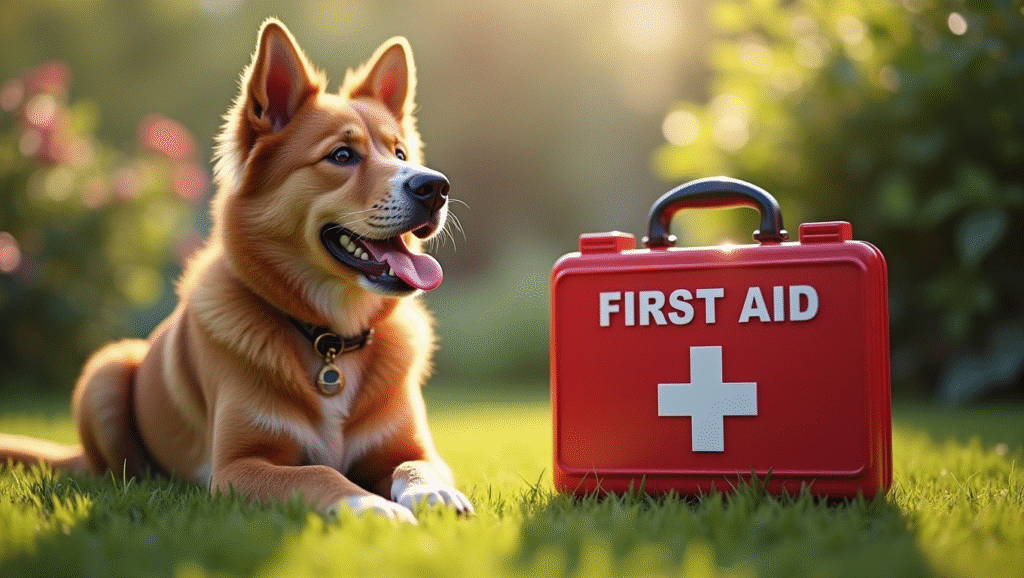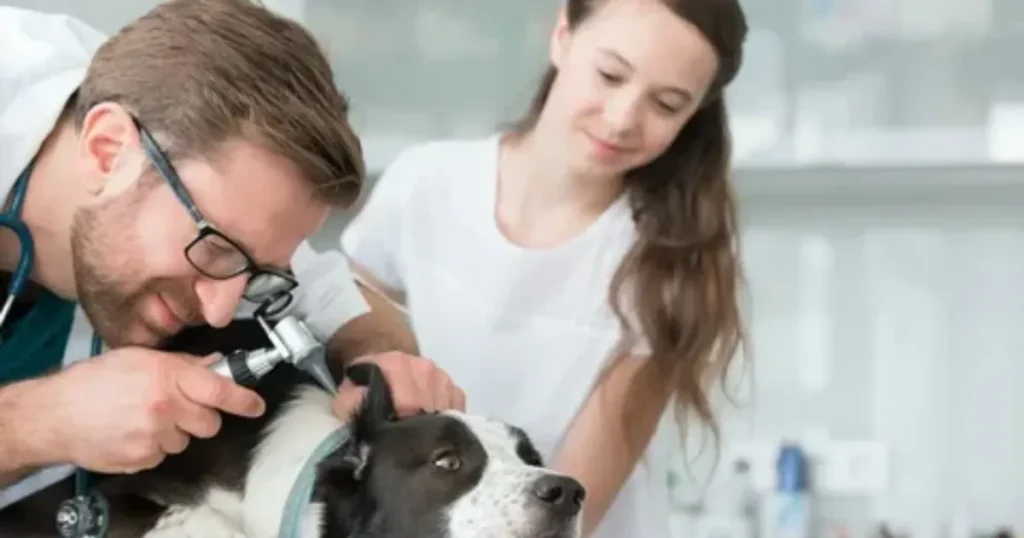In this Ultimate Guide How to Act in Dog Emergencies, you’ll learn all the key things to keep your furry friend safe when trouble strikes. It can be super scary when a dog emergency happens, but don’t worry!
We’ll cover common emergencies, how to recognize the signs, and first aid techniques you should know. You’ll also discover how to be prepared for anything that comes your way.
By the end of this guide, you’ll feel confident and ready to help your pup in a crunch!
Key Takeaways
- Stay calm when your dog is in trouble.
- Check for signs of injury or distress.
- Contact your vet or an emergency clinic quickly.
- Know basic first aid for dogs to help in emergencies.
- Keep emergency numbers handy at all times.

Summary
Understanding Dog Emergencies: What You Need to Know
When it comes to our furry friends, emergencies can happen in the blink of an eye. Whether it’s a sudden illness, an accident, or something else entirely, knowing how to handle these situations can make all the difference. Just like humans, dogs can face various emergencies that require quick thinking and action.
It’s important to understand what constitutes a dog emergency. This could be anything from a severe allergic reaction to a car accident or even a choking incident. The key is to recognize the signs early. Dogs can’t tell us when they’re in trouble, so we need to be observant and prepared.
Have you ever noticed your dog acting strangely? Maybe they’re panting excessively or have a swollen abdomen. These could be signs of distress. Being aware of your dog’s normal behavior can help you spot when something is off. And remember, when in doubt, it’s always better to err on the side of caution.
The Ultimate Guide How to Act in Dog Emergencies
So, what should you do if you find yourself in a dog emergency? First things first, stay calm. I know it’s easier said than done, but panicking won’t help your pup. Take a deep breath and assess the situation.
Here’s a simple step-by-step guide to follow:
- Stay Calm: Your dog can pick up on your emotions. If you’re panicking, they might become more anxious.
- Assess the Situation: Look for any obvious signs of distress. Is your dog bleeding? Are they unconscious? Knowing what you’re dealing with is crucial.
- Call for Help: If it’s a serious emergency, don’t hesitate to call your veterinarian or an emergency animal clinic. They can provide guidance on what to do next.
- Provide First Aid: If you’re trained in first aid and it’s safe to do so, you can start administering basic care. Familiarize yourself with first aid techniques to enhance your preparedness.
- Transport Safely: If you need to take your dog to the vet, make sure they’re secure in your vehicle. Use a crate or harness to keep them safe during transport.
- Follow Up: After the emergency, follow up with your vet for any necessary treatments or check-ups.
It might seem overwhelming, but having a plan can help you feel more prepared. And don’t forget, practice makes perfect!
Common Dog Emergencies: Recognizing the Signs
Recognizing the signs of a dog emergency is half the battle. Here are some common emergencies and what to look out for:
- Choking: If your dog is pawing at their mouth, coughing, or gagging, they might be choking. Check their mouth for any obstructions.
- Severe Allergic Reactions: Swelling around the face, difficulty breathing, or hives can indicate an allergic reaction. This can happen after eating something new or being stung by a bee.
- Heatstroke: Dogs can’t cool themselves off like we do. Excessive panting, drooling, or lethargy in hot weather can be signs of heatstroke.
- Trauma or Injury: If your dog has been in an accident or has fallen, look for limping, crying, or visible wounds.
- Vomiting or Diarrhea: While occasional upset stomachs are normal, persistent vomiting or diarrhea can lead to dehydration and may require immediate attention.
- Seizures: If your dog is shaking uncontrollably, they could be having a seizure. Keep them safe and clear of any hazards.
Knowing these signs can help you act quickly and effectively. And remember, if you’re ever unsure, it’s always best to consult with a vet.
First Aid for Dogs: Basic Techniques Every Pet Owner Should Know
First aid for dogs is a valuable skill that every pet owner should have. You never know when you might need it! Here are some basic techniques to keep in mind:
- Control Bleeding: If your dog has a cut or injury, apply gentle pressure with a clean cloth or bandage. Elevating the injury can also help reduce blood flow.
- Perform CPR: If your dog is unresponsive and not breathing, you may need to perform CPR. Make sure the area is clear and that your dog is on a flat surface. Knowing CPR techniques can be crucial in emergencies.
- Check for Breathing: If your dog isn’t breathing, you can try to give a few rescue breaths. Close their mouth and cover their nose with your mouth, blowing gently until you see their chest rise.
- Heimlich Maneuver: If your dog is choking, you can try the Heimlich maneuver. Stand behind your dog, place your hands just below their rib cage, and give a quick thrust inward and slightly upward.
- Treating Burns: If your dog has a burn, rinse the area with cool water for several minutes. Avoid using ice, as it can cause further damage.
- Wrapping Wounds: If your dog has a wound that needs protecting, use a sterile bandage to cover it. Make sure it’s not too tight, as this can cut off circulation.
These techniques can be lifesaving. It’s a good idea to consider taking a pet first aid course to gain more confidence and skills.
Want to see if the Snuggle Puppy Starter Kit really works? Check out my full review here: click here
Handling Dog Emergencies: Steps to Take Right Away
When an emergency strikes, every second counts. Here are the essential steps to take right away:
- Stay Calm: As mentioned earlier, keeping your cool is vital. Your dog needs you to be their rock.
- Assess the Situation: Look around for any potential dangers. Are there other pets involved? Is there something in the environment that could harm your dog further?
- Check Your Dog: Look for any obvious injuries or signs of distress. This will help you communicate effectively when you call for help.
- Call for Help: Don’t hesitate to reach out to your vet or an emergency clinic. They can guide you on what to do next.
- Follow Their Instructions: Listen carefully to what the vet says. They might give you specific instructions to follow before you arrive.
- Transport Safely: If you need to take your dog to the vet, make sure they’re secure and comfortable. If they’re injured, try to minimize movement as much as possible.
- Stay with Your Dog: If your dog is conscious, stay by their side and comfort them. Your presence can help ease their anxiety.
- Document Everything: If possible, take notes about what happened. This can be helpful for the vet when assessing the situation.
Being prepared can make a world of difference. And remember, your instincts are often your best guide.
Dog CPR Techniques: Saving Your Pup’s Life
Dog CPR is a critical skill that can save your pup’s life in an emergency. Here’s how to perform it:
- Check for Breathing: Before you start, make sure your dog isn’t breathing. If they are, don’t perform CPR.
- Position Your Dog: Place your dog on their side on a flat surface. If they’re small, hold them in your lap.
- Check for a Pulse: You can check for a pulse by feeling for the femoral artery, located inside the thigh. If there’s no pulse, you need to start CPR.
- Give Rescue Breaths: Close your dog’s mouth and cover their nose with your mouth. Blow gently until you see their chest rise. Repeat this every 30 seconds.
- Chest Compressions: For larger dogs, place your hands over their heart, which is located just behind the left elbow. For smaller dogs, use one hand to compress their chest.
- Continue Until Help Arrives: Keep alternating between rescue breaths and chest compressions until you can get your dog to a vet.
It’s a good idea to practice these techniques. You might even consider taking a dog CPR class. It’s one of those things that could really come in handy!
Emergency Vet Contacts: Keeping Important Numbers Handy
Having emergency vet contacts readily available can save precious time when every second counts. Here’s what to do:
- Create a List: Write down the contact information for your regular vet and any nearby emergency clinics. Don’t forget to include their hours of operation!
- Store It Safely: Keep this list in a place that’s easy to find, like on your fridge or in your wallet. You could even save the numbers in your phone for quick access.
- Know Your Vet’s Protocol: Some clinics have specific procedures for emergencies. Make sure you’re familiar with what to do when you call.
- Have a Backup Plan: If your regular vet isn’t available, know where the nearest emergency clinic is located.
- Consider Pet Insurance: If you haven’t already, look into pet insurance. It can help ease the financial burden in case of emergencies.
Being prepared with contacts can really make a difference. You’ll feel more at ease knowing you have a plan in place.
Pet Emergency Preparedness: Being Ready for Anything
Being prepared for emergencies isn’t just about having contacts; it’s about being ready for anything. Here are some tips to help you get started:
- Create a Pet First Aid Kit: Stock it with essentials like bandages, antiseptic wipes, gauze, and any medications your dog might need.
- Know Basic First Aid: Familiarize yourself with basic first aid techniques for dogs. You never know when you might need them!
- Keep Important Documents Handy: Have copies of your dog’s medical records and vaccination history in case you need to visit a new vet.
- Have a Plan for Evacuations: If you live in an area prone to natural disasters, have a plan for evacuating with your pet. Know where you can go and what you’ll need to take.
- Practice Emergency Drills: Just like you would for a fire drill, practice what you would do in an emergency with your dog. This can help you feel more confident and prepared.
- Stay Informed: Keep up with any changes in your dog’s health or behavior. If something seems off, don’t hesitate to consult your vet.
Being proactive can make all the difference. It’s all about creating a safety net for your furry friend.
Pet Safety Tips: Keeping Your Dog Out of Harm’s Way
Prevention is key when it comes to keeping your dog safe. Here are some practical tips to help you avoid emergencies:
- Keep Dangerous Items Out of Reach: Store cleaning supplies, medications, and any toxic plants away from your dog’s reach.
- Secure Your Yard: Make sure your yard is fenced and that there are no gaps where your dog could escape.
- Supervise Playtime: Keep an eye on your dog when they’re playing, especially around other animals or small children.
- Use a Leash: Always use a leash when walking your dog, especially in busy areas. This keeps them safe from traffic and other hazards.
- Be Cautious with Food: Some human foods are toxic to dogs. Make sure to keep chocolate, grapes, and onions out of their reach.
- Regular Vet Check-ups: Routine vet visits can help catch any potential health issues before they become emergencies.
- Microchip Your Dog: If your dog gets lost, having a microchip can help reunite you quickly.
By taking these precautions, you can help keep your dog safe and reduce the chances of emergencies.
Conclusion
In conclusion, being prepared for dog emergencies is not just a good idea; it’s a lifesaver. You’ve learned the importance of staying calm, recognizing signs of distress, and knowing basic first aid techniques. Remember, your furry friend relies on you to be their protector and advocate in times of trouble.
So, keep those emergency numbers handy, practice your skills, and make sure to have a solid plan in place. It’s all about being proactive and ready for anything that comes your way. After all, a little preparation goes a long way in ensuring your dog’s safety and well-being.
If you found this guide helpful, don’t stop here! There’s a treasure trove of information waiting for you at Tech Havela. Dive in and discover more tips to keep your beloved pup happy and healthy!
Frequently asked questions
What should I do if my dog is choking?
Stay calm. Check your dog’s mouth for the object. If you can see it, try to grab it. If you can’t see it, use the Heimlich maneuver.
For small dogs, hold them with their back against you. Make a fist just below the rib cage. Push inward and upward.
For large dogs, stand behind them. Wrap your arms around their belly and give quick thrusts.
How can I tell if my dog is in shock?
Look for signs like weakness, rapid breathing, or a weak pulse. Their gums may look pale too. Keep them warm and calm until you can get help.
What should I do if my dog has a seizure?
Make sure your dog is safe. Clear away sharp objects and avoid putting anything in their mouth. Time the seizure. Once it’s over, comfort your dog and keep them calm. Visit your vet for advice on what to do next.
How do I treat a bleeding wound on my dog?
Apply pressure with a clean cloth or bandage to stop bleeding. Keep pressure on it for a few minutes. If it doesn’t stop, call your vet.
What if my dog gets burned?
Cool the burn with running water for at least 10 minutes. Do not apply ice directly. Cover the burn with a clean cloth and go to your vet right away.
When should I go to the vet for my dog?
Take them if they are vomiting, have diarrhea, or seem very weak. If they can’t stand or walk, it’s time to go. Your dog’s behavior change is also a sign. Don’t wait!
Where can I find more tips on dog emergencies?
For more info, check the Ultimate Guide: How to Act in Dog Emergencies online. There are helpful tips and advice to keep your furry friend safe.
**Sidnir Vieira**
Founder of TechHavela
A passionate pet and tech content creator, helping dog owners across the U.S. make smarter decisions for their furry friends.



